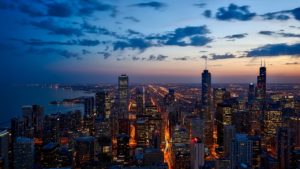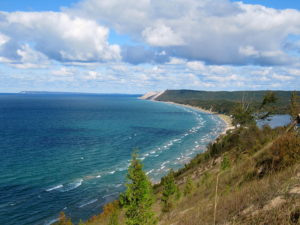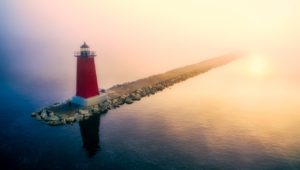
Lake Michigan is the only one of the Great Lakes located entirely within the United States. It is the second-largest of the Great Lakes by volume at 1,180 cubic miles and the third-largest by surface area at 22,404 square miles and can be measured to the state of West Virginia but slightly smaller. The northern part is in the colder, less-developed upper Great Lakes region. It is sparsely populated, except for the Fox River Valley, and is primarily covered with mixed wood forest. The more temperate southern basin of Lake Michigan is the most urbanized area in the Great Lakes system; it contains the Milwaukee and Chicago metropolitan areas. To the east, its basin is connected with Lake Huron through the wide Straits of Mackinac, giving it the same surface elevation as its easterly counterpart; the two are technically a single lake.
Lake Michigan is shared, from west to east, by the U.S. states of Wisconsin, Illinois, Indiana, and Michigan. Ports along its shores include Chicago; Milwaukee; Green Bay, Wisconsin; Gary, Indiana; and Muskegon, Michigan. The word “Michigan” originally referred to the lake itself, and is believed to come from the Ojibwe word michi-gami meaning “great water”.
Lake Michigan is joined via the narrow, open-water Straits of Mackinac with Lake Huron, and the combined body of water is sometimes called Michigan–Huron (also Huron–Michigan). The Straits of Mackinac were an important Native American and fur trade route.
After Lake Erie, the Lake Michigan basin has the second highest population. Major cities include Chicago, IL; Milwaukee, WI; and Green Bay, WI, each relying on the lake for shipping, municipal, and industrial water use. Chicago also uses canals and water control structures to drain up to 2.1 billion gallons of Lake Michigan water per day into the Mississippi River. Originally designed for wastewater management, the canals also affect invasive species introductions, navigation, and flood control.
The basin is a mix of residential, agricultural, and forested land with the majority of undeveloped land found in the northern part. Many popular vacation destinations attract tourists to the Lake Michigan shoreline. The rocky points, islands, and protected bays of northern Lake Michigan are a draw for communities along Wisconsin’s Door Peninsula and Michigan resort towns like Petoskey and Traverse City. Sandy beaches and dunes stretch along most of Lake Michigan’s eastern shore from Indiana Dunes National Lakeshore in the south to Sleeping Bear Dunes National Lakeshore in the north.

Twelve million people live along Lake Michigan’s shores, mainly in the Chicago and Milwaukee metropolitan areas. The economy of many communities in northern Michigan and Door County, Wisconsin is supported by tourism, with large seasonal populations attracted by Lake Michigan. Seasonal residents often have summer homes along the waterfront and return home for the winter. The southern tip of the lake near Gary, Indiana is heavily industrialized.
Cities on the shores of Lake Michigan:
Illinois: Chicago, Evanston, Glencoe, Highland Park, Kenilworth, Lake Forest, Lake Bluff, North Chicago, Waukegan, Wilmette, Winnetka, Zion
Indiana: East Chicago, Gary, Hammond, Michigan City,,Portage, Porter, Whiting
Michigan: Benton Harbor, Bridgman, Charlevoix, Douglas, Elberta, Escanaba, Ferrysburg, Frankfort, Gladstone, Glenn, Grand Beach, Grand Haven, Harbor Springs, Holland, Ludington, Manistee, Manistique, Menominee, Michiana, Muskegon, New Buffalo, Norton Shores, Pentwater, Petoskey, Saugatuck, St. Joseph, Shoreham, South Haven, Traverse City
Wisconsin: Algoma, Bay View, Cudahy, Fox Point, Green Bay, Kenosha, Kewaunee, Manitowoc, Milwaukee, Mequon, Oconto, Port Washington, Racine, Saint Francis, Sheboygan, Shorewood, South Milwaukee, Sturgeon Bay, Two Rivers, Whitefish Bay
Lake Michigan also has many beaches. The Great Lakes region is often referred to as the “Third Coast” of the United States, after those of the Atlantic Ocean and the Pacific Ocean. The sand is often soft and off-white, known as “singing sands” because of the squeaking noise (caused by high quartz content) it emits when walked upon. Some beaches have sand dunes covered in green beach grass and sand cherries, and the water is usually clear and cool, between 55 and 80 °F (13 and 27 °C), even in the late summer months. However, because prevailing westerly winds tend to move the surface water toward the east, there is a flow of warmer water to the Michigan shore in the summer.

The sand dunes located on the east shore of Lake Michigan are the largest freshwater dune system in the world. In fact, in multiple locations along the shoreline, the dunes rise several hundred feet above the lake surface. Large dune formations can be seen in many state parks, national forests and national parks along the Indiana and Michigan shoreline. Some of the most expansive and unique dune formations can be found at Indiana Dunes National Park, Saugatuck Dunes State Park, Warren Dunes State Park, Hoffmaster State Park, Silver Lake State Park, Ludington State Park, and Sleeping Bear Dunes National Lakeshore.
Small dune formations can be found on the western shore of Lake Michigan at Illinois Beach State Park and moderate sized dune formations can be found in Kohler-Andrae State Park and Point Beach State Forest in Wisconsin. A large dune formation can be found in Whitefish Dunes State Park in Wisconsin in the Door Peninsula. Lake Michigan beaches in Northern Michigan are the only place in the world, aside from a few inland lakes in that region, where one can find Petoskey stones, the state stone.

The beaches of the western coast and the northernmost part of the east coast are often rocky, with some sandy beaches due to local conditions; while the southern and eastern beaches are typically sandy and dune-covered. This is partly because of the prevailing winds from the west; which also cause thick layers of ice to build on the eastern shore in winter.
The Chicago city waterfront is composed of parks, beaches, harbors and marinas, and residential developments connected by the Chicago Lakefront Trail. Where there are no beaches or marinas, stone or concrete revetments protect the shoreline from erosion. The Chicago lakefront is accessible for about 24 miles between the city’s southern and northern limits along the lake.
Fishing:
Though 136 fish species are found in the Lake Michigan watershed, only 68 are found in the lake itself. Five deep water cisco species disappeared from the lake due to over-fishing and invasive species. Native strains of lake trout were also extirpated by the mid 1950’s. Harvest limits, habitat restoration, water quality regulations, and stocking programs have aided in partial recovery of some species, including lake trout, cisco, lake sturgeon, and Great Lakes muskellunge.
Lake Michigan is the birthplace of the Great Lakes salmon fishery. Coho salmon were successfully stocked in the Platte River in 1966, and chinook salmon followed in 1967. Recreational salmon and trout fisheries have fluctuated over the past fifty years, but Lake Michigan still supports a large charter fishing fleet that primarily targets the “big five” salmonines: chinook salmon, coho salmon, steelhead (rainbow trout), brown trout, and lake trout.
Some bays and drowned river mouth lakes offer excellent fishing for other species, including walleye and smallmouth bass. Lake whitefish continues to be the most popular and valuable commercial species on Lake Michigan, although catches have declined in recent years. State-licensed commercial fishers operate in Wisconsin and Michigan waters, and tribal commercial and subsistence fisheries operate in 1836 Treaty waters of northern Lake Michigan. In Illinois and Indiana, commercial fisheries for yellow perch closed in 1997.

Two passenger and vehicle ferries operate ferry services on Lake Michigan, both connecting Wisconsin on the western shore with Michigan on the east. From May to October, the historic steam ship, SS Badger, operates daily between Manitowoc, Wisconsin, and Ludington, Michigan, connecting U.S. Highway 10 between the two cities. The Lake Express, established in 2004, carries passengers and vehicles across the lake between Milwaukee, Wisconsin, and Muskegon, Michigan.
A few small cruise ships operate on Lake Michigan, including a couple of sailing ships. Many other water sports are practiced on the lakes, such as yachting, sea kayaking, diving, kitesurfing and lake surfing. The Great Lakes Circle Tour, a designated scenic road system, connects all of the Great Lakes and the St. Lawrence River.
Great Lakes passenger steamers have been operating since the mid-1800s. Several ferries currently operate on the Great Lakes to carry passengers to various islands, including Beaver Island and Bois Blanc Island (Michigan). Currently, two car ferry services traverse Lake Michigan from around April to November: the SS Badger, a steamer from Ludington, Michigan, to Manitowoc, Wisconsin, and the Lake Express, a high speed catamaran from Milwaukee to Muskegon, Michigan.
Fast Facts about Lake Michigan:
- the second largest
- the only Great Lake entirely within the United States
- variable climate, population density and development
- northern part: colder, less developed, sparsely populated
- southern basin: more temperate, among the most urbanized areas in the Great Lakes system.
- 20% of the total population of the Great Lakes basin
- Green Bay has one of the most productive Great Lakes fisheries but receives the wastes from the world’s largest concentration of pulp and paper mills
